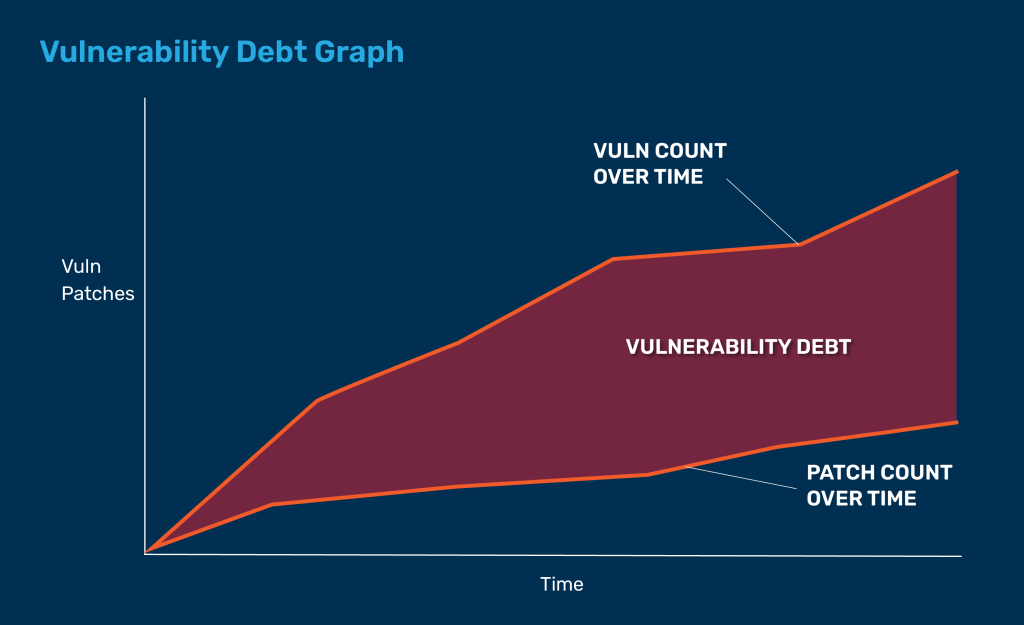You can’t easily measure the impact of a vulnerability in your network. To add salt to the wound, the impact is multi-fold. Not just monetarily, risks in your network can damage everything else, too. To measure this impact, security leaders around the world are leveraging the concept of vulnerability debt to quantify the impact of vulnerability debt.
The average cost of a cyberattack is 4.5 million USD, and that’s just the average. The number can drastically vary based on the size of your enterprise and the industry it is in as well. When we talk about vulnerability debt, each vulnerability can increase the potential cost of the cyberattack too.
In this blog, let’s dive into understanding the impact of vulnerability debt, quantify the potential impact, and see how you can reduce it with vulnerability management tools.
Quick Recap of Vulnerability Debt
Vulnerability debt is the number of security risks that accumulate over time when they are not patched. Here’s a simple visual representation of vulnerability debt.

The simplest comparison to a real-life scenario is the financial debt that increases when you don’t pay the borrowed amount on time!
Why You Should Care?
Vulnerability debt, while a new concept, can be a great measure to understand the impact vulnerabilities can have on your enterprise.
Visualizing and quantifying vulnerabilities and their impact will also help you take the right measures to secure your enterprise network.
But the bottom line here is that unpatched vulnerabilities are an open gateway for attackers to exploit your systems. It’ll result in cyberattacks, financial losses, reputational damage, and non-compliance penalties too.
I think these consequences should convince you to care about vulnerability debt.
The Potential Impact
Measuring potential impact is never easy. However, you can see the impact of vulnerability debt directly on your enterprise, too. Here are the three key domains where it can impact you:
- Increased cyberattacks: The longer a vulnerability is left unpatched, the higher the chances of it being exploited! And if it’s exploited, that’s an average expense of 4.5 million dollars. As your vulnerability debt increases, your attack surface increases, too, and that makes it evermore easier for cyberattackers to breach.
History is the best example, as some of the high-profile attacks were caused by unpatched vulnerabilities in the network. Equifax and Apache Struts could have been easily avoided if it was patched on time! - Rise in Cost: If you don’t patch a risk today, it’s going to cost you a lot more to patch it tomorrow. It is like the interest you pay on the debt and that’s the best way to look at it.
The cost associated can be mainly in two ways: manpower and the consequence of cyberattacks. You’d need more people/tools to patch risks if you postpone, or you’d have to pay ransom to cyber attackers or fines to regulatory bodies if you don’t patch risks! - Reputational impact: The immeasurable part of the potential impact, the damage of a cyberattack due to high vulnerability debt on your reputation, is immense.
Your business, business relations, trust with customers, and overall brand image quickly go downhill, especially when trust is important in certain industries! Cant really put a value on that now, can we?
Estimating the Impact of Vulnerability Debt
Now that we know the key areas where vulnerability debt can damage your enterprise, let’s try to measure the impact. This will give us a better understanding of the impact and hopefully convince us to take immediate action and reduce vulnerability debt.
- Monetary Loss: High vulnerability debt = Cyberattacks. And with the average cost of a cyberattack being 4.5 million and the average cost of fines from regulatory policies being 5000 – 20 million USD, the number can drastically rise. Here’s a rough estimate of what the vulnerability debt can translate to in terms of money
| Vulnerability Debt Range (number of unpatched vulns) | Potential Monetary Cost (USD) |
| <1000 | 4.5 million – 10 million |
| 1000 – 10000 | 10 million – 25 million |
| >10000 | > 25 million |
- Labour & Manpower Costs: High vulnerability debt = increased labor, manpower, and resource costs. While it is difficult to put a number on it, you need skilled security administrators and effective tools to patch vulnerabilities if they become too much to handle. And if a cyberattack happens, you’ll need to hire forensic teams, set up a response, and mitigate the damage, which doesn’t come cheap, either!
- Downtime & Time Lost: High vulnerability debt = increased downtime. When you don’t patch your devices, they might not work at their best and disrupt your business. If a cyberattack occurs, the devices might be locked or out of order, and the downtime can be humongous. Gartner suggests that the average cost of an hour of downtime is 5600$. Now, equating that to days and even weeks of downtime due to high vulnerability debt or cyberattacks, the number can range from 100-500k USD!
Conclusion
Vulnerability debt is not a problem that will drastically impact your business and must not be taken lightly. The consequences of high vulnerability are definitely not worth the risk you are putting your organization in.
Taking control of vulnerability debt today means fewer headaches and costs tomorrow.
So, reduce your vulnerability debt now!


